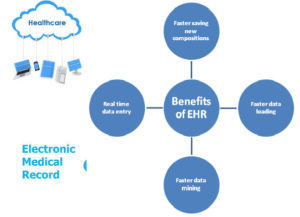An electronic medical record (EMR), also called as electronic health record (EHR) is a digital version of a paper chart that contains all of a patient’s medical history from one practice. The terms EHR and EMR have often been used interchangeably, although differences between the models are now being structured and defined. Electronic health record (EHR) is an evolving concept defined as a collection of the electronic health information of individual patients. The EMR is defined as the patient record created by providers for specific encounters in hospitals and ambulatory environments, and which can serve as a data source for an EHR.

Federal and state governments, insurance companies and other large medical institutions are heavily promoting the adoption of electronic medical records. The US Congress included a formula of both incentives and penalties for EMR/EHR adoption versus continued use of paper records as part of the Health Information Technology for Economic and Clinical Health (HITECH) Act.
An EMR is mostly used by providers for diagnosis and treatment. It eliminates the need to track down a patient’s previous paper medical records and assists in ensuring data is accurate and legible. Handwritten paper medical records, on the other hand may be poorly legible, which can contribute to medical errors.This is why industries like the medical field and many more are looking into aspects such as digitize and streamline agreement. This then allows documents to be in one place, digitally, rather than having paper trails that can easily be misplaced. The same also applies to electronic patient records.
Electronic records may help with the standardization of forms, terminology and data input and also facilitates the collection of data for epidemiology and clinical studies. EMRs can be continuously edited and updated. In addition, data from an electronic system can be used anonymously for statistical reporting in matters such as quality improvement, resource management and public health communicable disease surveillance.

Benefits of Electronic Medical Records
An EMR is more beneficial than paper records because it allows providers to:
- Track data over time
- Identify patients who are due for preventive visits and screenings
- Monitor how patients measure up to certain parameters, such as vaccinations and blood pressure readings
- Improve overall quality of care in a practice
The information stored in EMRs is not easily shared with providers outside of a practice. A patient’s record might even have to be printed out and delivered by mail to specialists and other members of the care team. Most times, electronic medical records help improve the quality of medical care given to patients. There have been cases where many doctors and office-based physicians refuse to get rid of the traditional paper records. Harvard University has conducted an experiment in which they tested how doctors and nurses use electronic medical records to keep their patients’ information up to date. The studies found that electronic medical records were very useful; a doctor or a nurse was able to find a patient’s information fast and easy just by typing their name; even if it was misspelled. In summary, the usage of electronic medical records can vary depending on who the user is and how they are using it.
